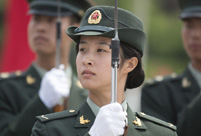 Chinese Kung Fu charms Silicon Valley
Chinese Kung Fu charms Silicon Valley
 Tranquil Yankou ancient town
Tranquil Yankou ancient town
 Lake Geneva: A show of swans
Lake Geneva: A show of swans
 Beautiful sunset over the Irtysh River
Beautiful sunset over the Irtysh River
 Qingjing Mosque: Witness of the ancient Maritime Silk Road
Qingjing Mosque: Witness of the ancient Maritime Silk Road
 Neiliansheng – more than 100 years of fashion
Neiliansheng – more than 100 years of fashion
 Golden retriever feeds baby African lions
Golden retriever feeds baby African lions
 Strange rocks in Lama Mountain
Strange rocks in Lama Mountain
 First overseas "China-standard" electric railway laid
First overseas "China-standard" electric railway laid
 College graduate launches organic agricultural cooperative in hometown
College graduate launches organic agricultural cooperative in hometownBEIJING, May 28 -- Intensive efforts are being made to draft an integration development plan for Beijing, Tianjin and Hebei Province, a senior official of China's top economic planning body said Wednesday.
"Drafting of the Beijing-Tianjin-Hebei Coordinated Development Program has advanced as we, together with other ministries, have completed a research report," said Fan Hengshan, deputy secretary general of the National Development and Reform Commission (NDRC) told a press conference.
The neighboring areas are faced with problems in coordinating development, Fan said. Beijing is overpopulated and overloaded with functions, and there is no clear delineation of roles and functions in the three locations, he told reporters.
The Beijing urban circle has a combined area of 216,000 square km. and a combined GDP of over 6 trillion yuan (about 1 trillion U.S. dollars) and a total population of 100 million. The integration program explores new urbanization models for Beijing as people flood into the capital seeking better education, medical care and jobs. There are also too many cities and townships in the region which is choked by uneven development, a water shortage, and serious air pollution.
As for the timetable, Fan said, "We will try to make it as soon as possible while ensuring the quality of the program."
The program will be drafted to solve the problems of integrated development, reassessing and redefining the functions of the three localities in infrastructure, industrial upgrades and coordination, environmental protection, public services, and market system building, Fan said.
Another target of the program is efficiency of systems and mechanisms in the region, which should be an example for national transformation and institutional transition, with concrete support in finance, industry, investment, population, social security, environmental protection and land.
Fan's statement came three months after President Xi Jinping called for integrated, coordinated development of the region around Beijing in terms of functions, industrial distribution, urban layout, transportation, and others, with detailed measures in finance, investment and project schedules.
The idea of a regional cooperative bloc is not a new one for China. Shanghai's Yangtze River Delta and the Guangzhou's Pearl River Delta have brought economic booms to their cities thanks to coordinated industrial and commercial partnerships.
This integration push will concentrate on infrastructure development in Hebei Province, enriching Tianjin's industrial pattern, and by easing Beijing's urban malaise, Yi Peng, an urban development researcher, told Xinhua in a previous interview.
 Opening ceremony of 67th Cannes Film Festival
Opening ceremony of 67th Cannes Film Festival Pulse of Xiamen - Int'l Yoga art festival in May
Pulse of Xiamen - Int'l Yoga art festival in May Photo story: Life of a scrap metal recycle worker
Photo story: Life of a scrap metal recycle worker Training of the PLA's first female honor guard
Training of the PLA's first female honor guard China's 10 must-see animations
China's 10 must-see animations Female bodybuilders show their beauty of fitness
Female bodybuilders show their beauty of fitness A taste of Harbin cuisine
A taste of Harbin cuisine A bite of Jiang Nan
A bite of Jiang Nan Who is China's campus beauty queen?
Who is China's campus beauty queen? 8 great movies to watch with your mom
8 great movies to watch with your mom China's most luminous celebrities
China's most luminous celebrities Newly recruited police in Hetian hold drill
Newly recruited police in Hetian hold drill  Bird-men compete flying in Hong Kong
Bird-men compete flying in Hong Kong  The 'Chinese Dad'
The 'Chinese Dad' Shanghai locals bid farewell to childhood memories
Shanghai locals bid farewell to childhood memoriesDay|Week|Month